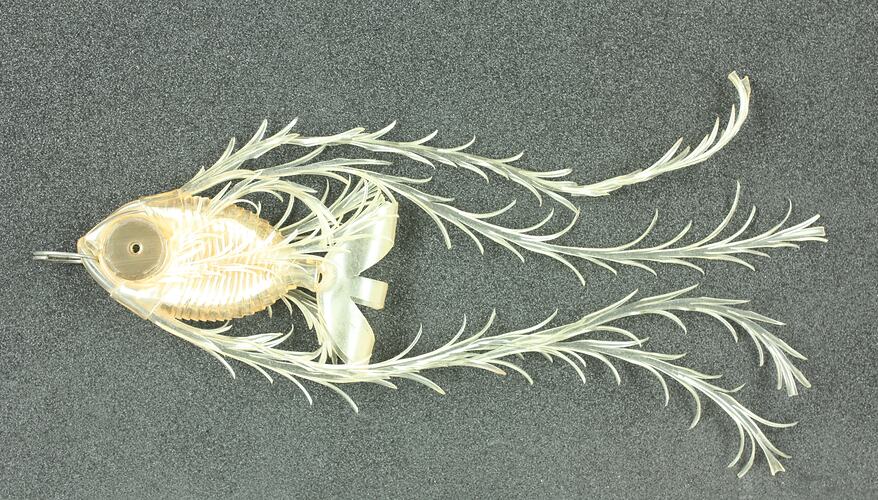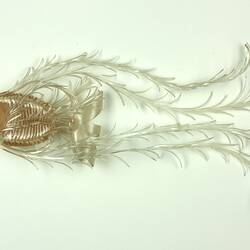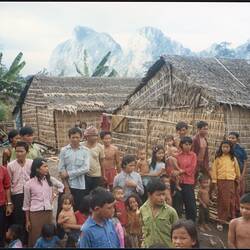Summary
This prawn keyring was crafted from recycled plastic by refugees in Phanat Nikhom Camp in Thailand. It is one of only two surviving keyrings that were given to Department of Immigration Senior Migration Officer Jennie Roberts, between 1987 and 1989 when she was working in various refugee camps in Thailand.
Manual activity was prolific in the camps, the main objective being to make items (often from recycled materials) needed by the camp residents. Another motivation was to try to earn some money from the sale of the items, to other refugees, or to workers in the camps. Some of the camps had a small 'gift shop' where staff, visiting officials, or interview teams could purchase items. In camps people plied their trades as best they could, utilising their expertise in such activities as gold and silver jewellery making, gemstone setting, wooden furniture making, hairdressing, dressmaking and tailoring, drawing and painting, and weaving (by Lao and Khmer refugees).
Jennie Roberts was posted as a Senior Migration Officer to Bangkok in Thailand from 1987 to 1989, when Australia had an extensive program for south-east Asian refugee and humanitarian entrants, primarily from Vietnam, Laos and Cambodia. Based in the Visa Office at the Australian Embassy, Jennie and her colleagues frequently travelled to UNHCR refugee camps in Thailand to interview applicants. This included visits to camps such as the Phanat Nikhom camp, 100 kilometres south east of Bangkok, which was primarily a transit camp for people already selected for relocation by Australia and other countries where they undertook orientation courses and health procedures. Other camps included the Khao I Dang camp on the Thai-Cambodian border, mainly for Kmer refugees available for resettlement. The staff were responsible for deciding temporary and permanent visa applications, also including people from Burma and Bangladesh.
Most of Jennie's work during her two year posting was associated with the Refugee and Special Humanitarian Programs (RSHP) in Thailand and the Vietnam Family Migration Program (VFMP) in Vietnam. The VFMP was implemented to reunite families in Vietnam with relatives who had fled Vietnam after 1975. These were people who remained in temporary asylum in various south-east Asian countries or who had arrived in Australia by boat.
Physical Description
Keyring consisting of a fish cut and folded from recycled plastic attached at its mouth to a metal ring. The body of the fish has scales and its face has an eyehole punched through from one side to the other. There is a rounded moulded tail and there are four long trailing barbed pieces and six shorter barbed pieces.
Significance
This important and rare collection of photographs and craft represents two sides of the asylum experience - the refugees and the government officials. These parallel and intersecting experiences have both personal and bureaucratic elements to them, linked by place, and world events, with craft and a gift of appreciation providing tangible points of connection and memory. The experiences of migration officials are frequently untold and unrepresented by material culture, as are material manifestations of refugee narratives. This collection enables the telling of both stories, with primacy given in this instance to the employee as custodian of the objects. The photographs provide an insight into refugee camp life for both residents and workers through the eyes of an Australian immigration official. The collection is also a symbol of a particular period in Australian migration history when support for refugee programs had both bipartisan and public support. Finally the theme of refugee, internee and detainee craft recurs across time and place and provides a tangible connection between very different human experiences, the trauma, economy and the tedium of which has been consistently alleviated through artistic practice.
More Information
-
Collecting Areas
-
Acquisition Information
Donation from Jennie Roberts, 18 Jun 2012
-
Collector
Ms Jennie Roberts - Department of Immigration, Local Government and Ethnic Affairs, Thailand, 1987 - 1989
-
Classification
Migration, Processing - immigration selection, Refugee camps
-
Category
-
Discipline
-
Type of item
-
Keywords
Art, Artistic Practices, Plastics, Crafts, Immigration, Refugees, Immigration Selection, Vietnamese Immigration, Vietnam War Refugees





